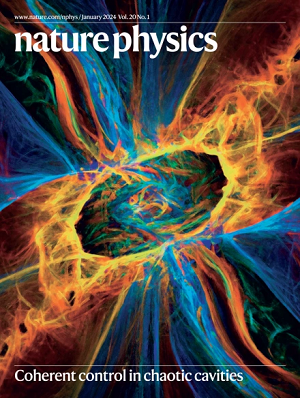在Rydberg模拟模拟器中预测拓扑纠缠熵
IF 18.4
1区 物理与天体物理
Q1 PHYSICS, MULTIDISCIPLINARY
引用次数: 0
摘要
预测拓扑物质的动力学性质是一项具有挑战性的任务,不仅在理论和实验设置,而且在计算。数值研究通常局限于研究简化的模型和格。本文提出了一种在里德伯原子模拟器上动态制备量子自旋液态的时间相关分析方法。结合时变分蒙特卡罗技术,我们可以在整个动态准备过程中忠实地表示系统的状态。我们不仅能够匹配里德伯原子哈密顿量的物理正确形式,而且能够在超出当前实验能力的系统尺寸上匹配相关的晶格拓扑结构。这种方法提供了对全局量的访问,如拓扑纠缠熵,提供了对系统拓扑特性的洞察。我们的研究结果证实了动态制备过程中状态的拓扑性质,加深了我们对拓扑纠缠动力学的理解。我们表明,虽然模拟状态显示出类似于共振价键状态的局部特性,与实验观察一致,但无论协议的绝热程度如何,它都缺乏后者的特征拓扑纠缠熵签名。本文章由计算机程序翻译,如有差异,请以英文原文为准。


Predicting topological entanglement entropy in a Rydberg analogue simulator
Predicting the dynamical properties of topological matter is a challenging task, not only in theoretical and experimental settings, but also computationally. Numerical studies are often constrained to studying simplified models and lattices. Here we propose a time-dependent correlated ansatz for the dynamical preparation of a quantum-spin-liquid state on a Rydberg atom simulator. Together with a time-dependent variational Monte Carlo technique, we can faithfully represent the state of the system throughout the entire dynamical preparation protocol. We are able to match not only the physically correct form of the Rydberg atom Hamiltonian but also the relevant lattice topology at system sizes that exceed current experimental capabilities. This approach gives access to global quantities such as the topological entanglement entropy, providing insight into the topological properties of the system. Our results confirm the topological properties of the state during the dynamical preparation protocol, and deepen our understanding of topological entanglement dynamics. We show that, while the simulated state exhibits local properties resembling those of a resonating-valence-bond state, in agreement with experimental observations, it lacks the latter’s characteristic topological entanglement entropy signature irrespective of the degree of adiabaticity of the protocol. A numerical approach capable of simulating large-scale Rydberg atom quantum systems suggests that protocols for preparing topological states can produce experimental signatures of these states without reaching a topological phase.
求助全文
通过发布文献求助,成功后即可免费获取论文全文。
去求助
来源期刊

Nature Physics
物理-物理:综合
CiteScore
30.40
自引率
2.00%
发文量
349
审稿时长
4-8 weeks
期刊介绍:
Nature Physics is dedicated to publishing top-tier original research in physics with a fair and rigorous review process. It provides high visibility and access to a broad readership, maintaining high standards in copy editing and production, ensuring rapid publication, and maintaining independence from academic societies and other vested interests.
The journal presents two main research paper formats: Letters and Articles. Alongside primary research, Nature Physics serves as a central source for valuable information within the physics community through Review Articles, News & Views, Research Highlights covering crucial developments across the physics literature, Commentaries, Book Reviews, and Correspondence.
 求助内容:
求助内容: 应助结果提醒方式:
应助结果提醒方式:


